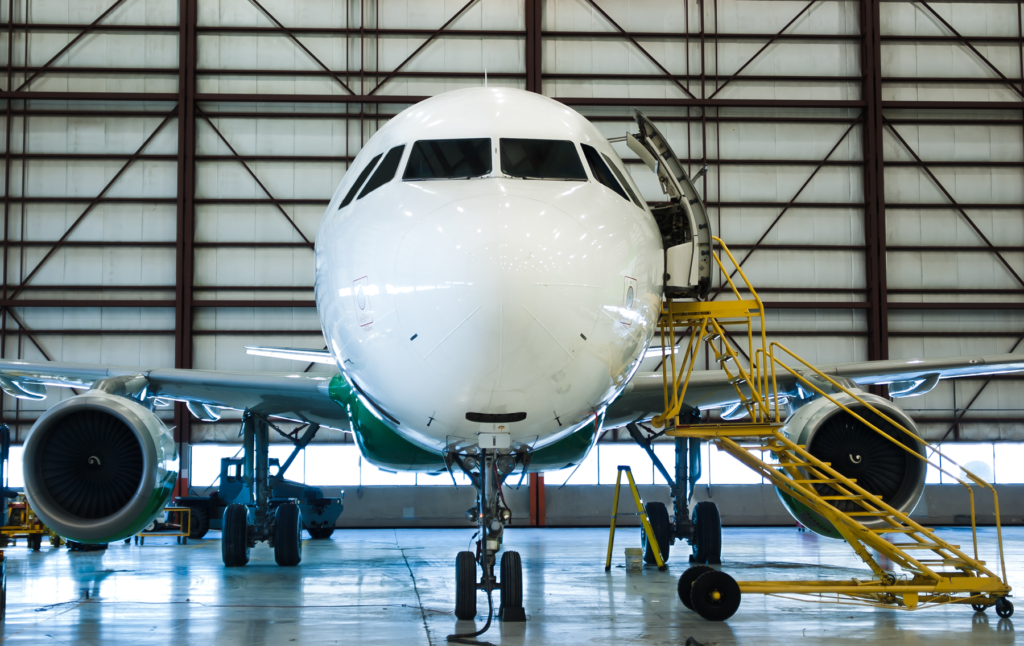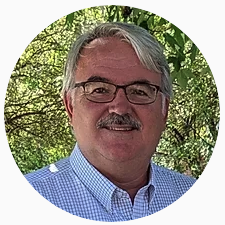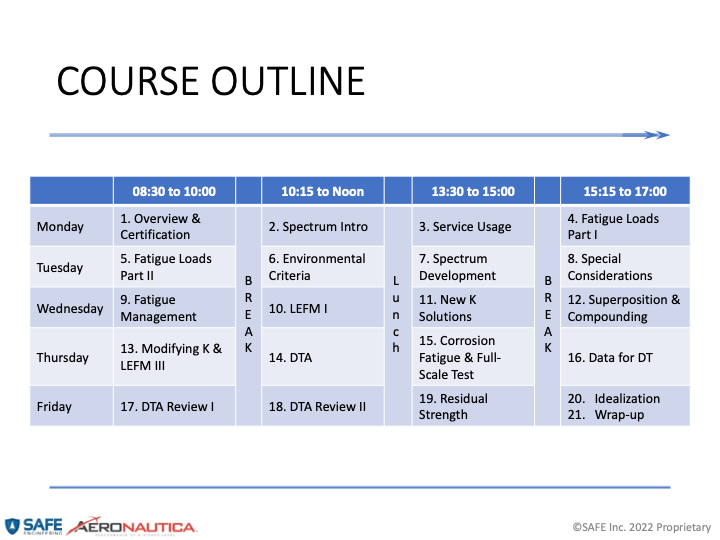Courses
SHORT COURSE ON DAMAGE TOLERANCE METHODS FOR AIRWORTHINESS
Upcoming Courses
Damage Tolerance Methods for Airworthiness
Sept 26-30, 2022 – Colorado Springs, CO
Hilton Garden Inn Colorado Springs Downtown

Who is this course for?
This course is for the engineering professional currently working on aircraft structures damage tolerance evaluations for civil or military aircraft.
Pre-Requisites
- ABET accredited degree in Engineering Mechanics, Aerospace/Aeronautical Engineering, Mechanical Engineering or Civil Engineering
- 3 years of airframe stress analysis
- 1 year of damage tolerance analysis
- Experience in linear elastic fracture mechanics
- Experience with AFGROW, NASGRO, or Cracks2000
Course Outline
- Overview of FAA FDT Certification
- Fatigue Loads and Spectra Development
- Introduction
- FAA Requirements & Guidance
- Fatigue versus Design Environment
- Mission Profiles and Usage
- Aircraft Parameters
- External Loads
- Internal Loads
- Load Histories
- Dynamic Effects
- Spectrum Development
- Options for Fatigue Management
- Fatigue Substantiation
- Fatigue criticality – Stress severity factor
- Damage Tolerance and Fatigue Evaluation of Structure
- Select Details of Interest
- Single Load Path, Multiple Load Path, Inspectable and Non-inspectable
- Select Details of Interest
- Stress Analysis
- Industry Standard Methods
- Finite Element Analysis
- Initial Flaw Sizes
- Stress Intensity Factors
- Corner Cracks at a Hole
- Corner Cracks at a Hole – Flaw Shape Development
- Corner and Through Cracks at a Hole
- Superposition and Compounding
- Complex Structure
- Bending Restraint
- Bulging Factor
- R vs. Kmax and R vs. DK
- Materials
- Materials Characterization
- Detectable Crack Lengths
- Probability of Detection
- Fatigue Crack Growth Models
- Paris
- Walker
- Forman
- Forman-Newman-de Koning
- Fatigue Crack Growth Life
- Spectrum Types
- Membrane, Bending, Bearing Loading Effects
- Residual Strength
- Inspections
- Safeguard the Airplane
- How to Develop an Inspection Program
- Does ICA reflect the inspection requirement of the PSE
- Impact on existing inspections
- Inspecting Detail vs. Area
- Prototype new inspections
- DTA Methods and Examples
- Data Required for FAA Approval
- Comparative Analysis
- Small Antenna Installation
- Spot Welded Joints
- MSD/MED
Sept 26-30, 2022 – Colorado Springs, CO
Hilton Garden Inn Colorado Springs Downtown
James Burd
FAA DER STRUCTURES AND DAMAGE TOLERANCE President, Aeronautica LLC
James Burd has over 30 years of experience in the aircraft industry as a structures, stress, and damage tolerance engineer. He graduated from North Carolina State University in 1987 with a degree in Aerospace Engineering. James started his career in the USAF where he served as the C-5 Aircraft Structural Integrity Program (ASIP) Manager. Upon leaving the USAF, James worked on several DOD related programs at L-3 Systems and Northrop Grumman including the full scale fatigue test of the USN E-6A Milstar radome and the E-8C JStars ASIP program. Subsequently, James worked at Gulfstream Aerospace for several years in the fatigue and damage tolerance group and later worked at Lockheed Martin on the L-1011 aging aircraft program. From 1998 until 2004, James also served as a participating member on the Aviation Rulemaking Advisory Committee (ARAC) for Widespread Fatigue Damage (WFD) and the Aging Airplane Safety rule. In 1998, James became an FAA Designated Engineering Representative (DER) for Structures and Fatigue/Damage Tolerance. He presently retains delegations for Part 23, Part 25, Part 26, Part 27 and Part 29 regulations and has supported certification efforts on a large number of platforms. James currently supports engineering and certification projects for numerous civil and government projects with his team at Aeronautica. In particular, they support fatigue, damage tolerance and continuing airworthiness evaluations.
Scott Fawaz
FAA RS-DER STRUCTURES AND DAMAGE TOLERANCE President, SAFE Inc.
Dr. Scott Fawaz graduated from the United States Air Force Academy in 1987 having obtained an Engineering Mechanics degree with distinction. In 1988, he received his Master of Aeronautical Engineering from the Air Force Institute of Technology. In 1997, he received his doctorate in Aerospace Engineering from the Technical University Delft, The Netherlands. He served 23 years in the United States Air Force working in the area of aircraft structural integrity of new and aging aircraft. He had assignments at the San Antonio Air Logistics Center, Air Force Research Laboratory, and United States Air Force Academy (USAFA). At USAFA he was on the teaching faculty and also directed the Center for Aircraft Structural Life Extension (CAStLE) from 2003 – 2010. After leaving the USAF, he led the fatigue and damage tolerance group for the Gulfstream G650. With several government and commercial contract awards for SAFE in 2011, Dr. Fawaz focused all his efforts at SAFE. Currently, he is supporting civil and military aviation basic and applied research, advanced technology development, demonstration and validation, engineering and manufacturing development. Dr. Fawaz is also a FAA Designated Engineering Representative (DER) for Structures and Damage Tolerance with Repair Specification authority.
Cost Per Attendee
$2,500 (does not include travel, lodging, or food)
Discounts
10% discount on registration with registering 3 or more participants
Participant Limit
25 Attendees



